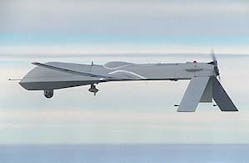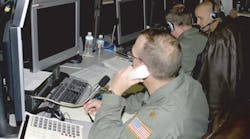WASHINGTON — Efforts to counter terrorism, which have cost taxpayers more than a billion dollars a month since the Sept. 11 attack, are projected to exceed $2 billion a month under the new defense budget that President Bush submitted to Congress Feb. 4.
The $379.3 billion sought for the U.S. Department of Defense (DOD) for fiscal year 2003, which begins Oct. 1, is up 13 percent from this year's level of $334.3 billion. The request includes $27.2 billion earmarked for anti-terrorism, up from this year's appropriated $10.5 billion, but already indications are that both those numbers will rise.
DOD Comptroller Dov Zakh-eim cautions that federal officials retroactively added a supplemental request for an additional $13.7 billion to last year's DOD budget for anti-terrorism, which brought that figure up to $18.9 billion. Further, Zakheim says he anticipates another supplemental request for the current fiscal year as early as this month. The amount has yet to be determined, according to Zakheim.
The increases across the board at the Pentagon are the highest since the Reagan administration, as measured in constant dollars. These increases also represent the largest component of the planned $75.9 billion increase in the total federal budget for the coming fiscal year, now projected at $2.13 trillion.
The shopping listOf greater significance to the electronics industry than these top line numbers, however, is what the money will buy. The Pentagon shopping list includes weapon systems directly applicable to the anti-terrorist activity.The list includes the joint Direct Attack Munitions (JDAM) program, laser-guided bombs, improved Tomahawk cruise missiles, upgrades to intelligence capabilities, acceleration of unmanned air vehicle/unmanned combat air vehicle (UAV/UCAV) programs, and improved space assets.
The anti-terrorism program is wrapped into the planned transformation of the military infrastructure that had been in progress before the Sept. 11 attacks in an attempt to achieve "maneuver and air dominance" with an increasingly all-stealth fighter force and future combat system.
At last year's Quadrennial De-fense Review (QDR) exercise, Defense Secretary Donald Rumsfeld approved plans to scrap the ability to engage concurrently in two major regional conflicts — the so-called 2MRC policy of the Cold War period — and move toward a more flexible structure capable of responding to a variety of threats.
For example, the new budget request envisions continuing the controversial National Missile Defense program at its current level of $7.8 billion to counter ballistic missile attacks by lesser powers, and gradually building up to $11.1 billion over the next five years.
Other components of the transformation package include a billion dollars next year to convert Ohio-class ballistic missile submarines to fire cruise missiles, $707 million for the Army's Future Combat System, $826 million for an advanced extremely high frequency (EHF) satellite communications system, $43 million to accelerate space-based radar development, $629 million to improve the Global Hawk UAV, $141 million to accelerate development of other UAVs, $158 million to upgrade the Predator UAVs, and $83 million to start developing an unmanned underwater vehicle for the Navy.
Also under the transformation category are $1.3 billion next year to expand wideband secure global communications, $3.3 billion for intelligence collection, and $54 million to develop a small-diameter bomb for precision strike munitions. These are all likely to have a substantial electronics content.
Other approved big-ticket weapons in the new budget with at best a tenuous relationship to anti-terrorism are: $475 million for the Army's Crusader self-propelled artillery piece originally conceived to counter Soviet troops invading Western Europe; $5.2 billion for the Air Force's F-22 advanced tactical fighter, $3.5 billion for the multi-service F-35 Joint Strike Fighter, and $3.3 billion for the Navy's upgraded F/A-18 Superhornet fighter-bomber.
In fact, President Bush had questioned the need for all three aircraft during the 2000 presidential campaign, suggesting instead that the Pentagon forgo upgrading the current generation of aircraft and move to a new family of tactical aircraft embodying all-new technology.
Moreover, Navy leaders are due to build only five new ships under the 2003 budget request, which Rumsfeld concedes will not be sufficient to maintain the current 310-ship fleet. The Reagan administration had placed the highest priority on maintaining a 600-ship fleet.
A particularly healthy trend for the technology segment of the defense industry, according to Comptroller Zakheim, is the administration's commitment to increase science and technology funding. The growth from this year's $8.8 billion to $9.9 billion in the 2003 request maintains that level at 2.7 percent of the total DOD budget, but Zakheim says the goal is to achieve 3 percent.
Typical items in this category include the Army's future combat systems and electronics for the Navy.




